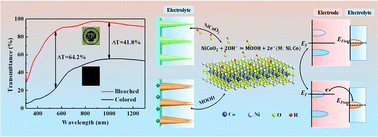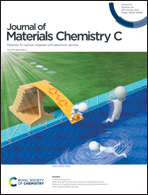Growth of a porous NiCoO2 nanowire network for transparent-to-brownish grey electrochromic smart windows with wide-band optical modulation†
Abstract
Electrochromic smart windows can dynamically regulate the transmittance of solar radiation to reduce the energy consumption and improve occupants' comfort in the building. Metal oxide-based electrochromic materials are highly desired owing to their high optical modulation and good environmental stability. However, the monometal oxide is still not competent to satisfy the electrochromic neutral tinting over the broad visible-near-infrared (Vis-NIR) range. Here, we report a bimetallic NiCoO2 nanowire electrochromic film which can simultaneously achieve a large optical modulation over the wide-band Vis-NIR range (64.2% at 550 nm and 41.8% at 1000 nm) and high gravimetric capacity (33.6 mA h g−1 under 0.25 A g−1). In addition, the NiCoO2 nanowire film also exhibits transparent-to-brownish grey switching characteristics with fast switching speed (6.8/6.7 s) and good optical memory (24 000 s). Moreover, the optimized NiCoO2 and the MnO2 films are further assembled into the multifunctional smart window, which can monitor the energy storage status in real-time via the color variation. It is believed that the design strategy for bimetallic oxides can immensely extend the application of electrochromic smart windows with dual-band regulation and neutral tinting.



 Please wait while we load your content...
Please wait while we load your content...